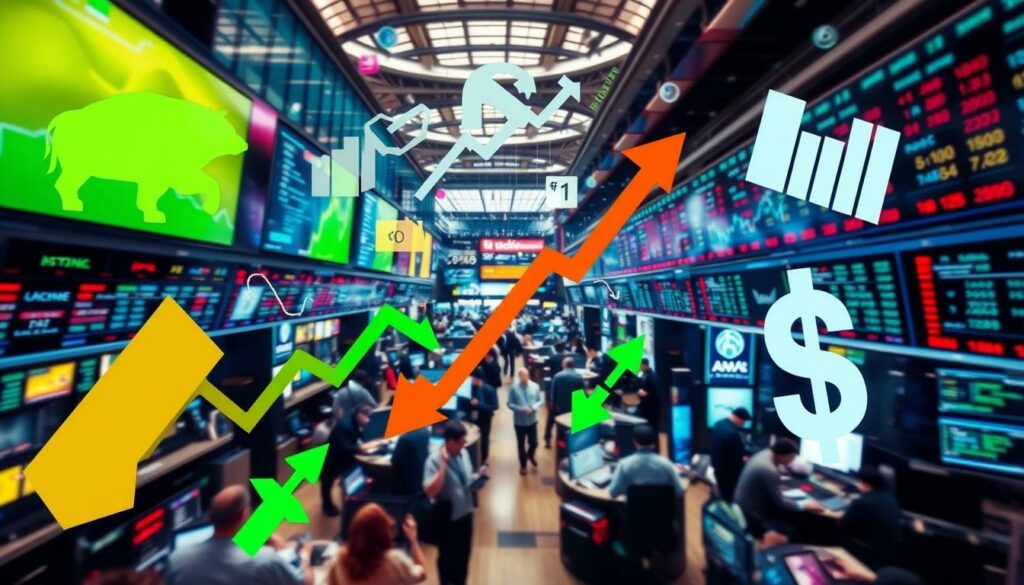Investing in the stock market can feel like stepping into uncharted waters. Many people start by wanting financial freedom or a better future for their loved ones. The stock market is a way to get to that freedom, but it’s full of complex terms and fast changes.
For those new to this, learning the basics of stock trading is key. It helps people make smart choices that can change their financial future.
This article will cover everything you need to know about the stock market. It will explain what the stock market is and important terms every investor should know. It’s for anyone new or looking to refresh their knowledge. This is where your investing journey starts.
What is the Stock Market?
The stock market is a place where people buy and sell shares of companies. It helps companies get the money they need to grow and innovate. The New York Stock Exchange (NYSE) and Nasdaq are key places where these deals happen online.
When people buy and sell stocks, many things affect the prices. For example, if more people want a company’s shares, the price might go up. If there are more shares than buyers, the price could drop. Many types of investors, from big ones to regular folks, are in the market for different reasons.
There are more ways to trade than just common stocks. The OTC markets let investors trade directly with each other, with less government watch. American depositary receipts (ADRs) make it easy for Americans to buy shares of foreign companies. Mutual funds and ETFs also offer ways to invest in certain areas of the market.
The SEC makes sure the stock market is fair and open. It’s important for investors to keep up with news about the stock market. This news helps them understand what’s happening with prices and why.
Key Stock Market Terms Every Investor Should Know

Knowing stock market terms is key to understanding investing. It helps you make smart choices and manage your money well. Some terms are very important for making good decisions and understanding the market.
Essential Vocabulary for Investors
Here are some key terms for anyone who wants to invest in stocks:
- Arbitrage: This is when you make money by using price differences in the same asset across markets.
- Bull Market: This means stock prices are going up, showing a strong economy.
- Bear Market: This is when stock prices drop by 20% or more, showing investors are worried.
- Dividend: A company gives out part of its earnings to its shareholders, which can add to your income.
- Market Capitalization: This is the total value of a company based on its shares.
- Liquidity: This is how easy it is to buy or sell an asset without changing its price.
- P/E Ratio: This ratio compares a stock’s price to its earnings, helping to see if it’s a good value.
- Yield: This is the income you get from owning a security, often from dividends.
| Term | Definition |
|---|---|
| Beta | A measure of how risky an asset is compared to the market, with higher values meaning more risk. |
| Volume | The number of shares traded in a set time, showing how active the market is. |
| Bid-Ask Spread | The price difference between what buyers and sellers are willing to accept for a stock. |
| Mutual Funds | These are investments that pool money from many people to buy a mix of stocks, with some costs. |
| Growth Stocks | These are stocks expected to grow more than average, so they cost more. |
| Day Trading | Buying and selling financial items all within one day. |
The Importance of Stock Trading in Modern Economies
Stock trading is key in modern economies. It helps move money from investors to businesses. This is vital for companies to grow and innovate.
A strong stock market lets investors make money. This helps the economy stay healthy.
Stock prices tell us a lot about the economy. When prices go up, it means people are feeling good about investing. This can lead to more growth. But if prices drop, it might mean trouble ahead.
The S&P 500 tracks 500 big U.S. companies. It covers many areas, but mostly traditional sectors. The TSX in Canada is more focused on these sectors.
The U.S. market has less focus on these sectors. It leans more towards sectors that do well in good and bad times.
- Impact of Economic News: News that surprises investors can change how people feel about the market.
- Opportunities Amidst Adversity: When the economy looks bad, stocks can be a good buy. Smart investors see the potential.
- Wealth Distribution: Stocks make up about 35.5% of household wealth. This shows how important investing in stocks is for personal finance.
How the stock market does affects how much people spend. Spending makes up about 70% of the U.S. economy. When markets go up, companies can make more money. This helps everyone involved.
So, stock trading is a key way to see and shape the economy. It reflects and changes important parts of our economic world.
Understanding Stock Prices and Market Demand

Stock prices show how much people want a stock. This want is based on things like how people feel, the economy, and how well a company does. When more people want a stock, its price goes up.
This brings up a key point about price changes. Prices move up or down based on how much people want to buy and sell. Knowing this is key for anyone looking into the stock market.
Looking at market caps helps us understand stock prices better. Stocks are grouped as mega-cap, large-cap, mid-cap, small-cap, micro-cap, or nano-cap. Each group shows the company’s size and risk level. This affects how they handle market changes.
- Mega-cap: Over $200 billion
- Large-cap: $10 billion to $200 billion
- Mid-cap: $2 billion to $10 billion
- Small-cap: $300 million to $2 billion
- Micro-cap: $50 million to $300 million
- Nano-cap: Under $50 million
Things like inflation and the strength of other markets also change prices. Big companies can move fast when news comes out. They are more liquid and attract big investors who can change prices a lot.
How people feel about the market also changes stock prices. Fear or excitement can make prices jump. Investors look for good deals to invest in.
Looking at companies like Autozone and Microsoft shows these ideas. Autozone is at $3,162.50 per share with a big market cap. Microsoft is at $413.39 per share with an even bigger market cap. These numbers help us see how strong a stock might be.
In short, knowing how supply and demand affect stock prices is key for investing. When demand goes down, prices fall until they’re good for buyers. This helps keep the market balanced.
The Role of Stock Exchanges

Stock exchanges are key for buying and selling shares in the stock market. The NYSE and Nasdaq are big names in finance. They make sure trading is smooth and fair.
The NYSE has rules like a share price of $4 and a market value of $4 million. This keeps companies at a high standard. Nasdaq also has rules, like a $11 million income and a $45 million market value.
This makes investors trust the market more. It also makes trading more reliable.
Trading in the U.S. stock market is open Monday to Friday, from 9:30 a.m. to 4 p.m. Eastern time. This schedule lets investors join in easily. It keeps the market running smoothly.
Some companies trade their stocks over the counter (OTC) to save money. OTC stocks can be very cheap and not very liquid. Vanguard stopped buying most OTC securities on April 28, 2022, showing changes in the market.
Stock exchanges help the economy by making it easier to invest and trade. They keep companies honest with rules and public reports. They help set stock prices by matching buyers and sellers.
Types of Stocks: Common and Preferred

Investors have two main types of stocks: common and preferred. It’s important to know the differences to make smart choices.
Common stock lets you own part of a company. You get to vote on big decisions. Each share usually means one vote, helping you have a say in things like choosing the board.
Preferred stock doesn’t let you vote. But, it has perks like getting dividends first. This means you get money before common stockholders, making it more stable.
Common stock can be riskier because its value can change a lot. If a company goes under, common stockholders might not get paid first. This shows how stock types have different levels of protection.
- Common Stock
- Voting rights typically at one vote per share.
- Higher long-term growth potential.
- More price volatility and risk of substantial loss.
- Preferred Stock
- Priority for dividends and during liquidation.
- No voting rights.
- Less volatility, providing stability similar to bonds.
Before picking stocks, think about what you want from your investment. The choice between common and preferred stock can change how well your portfolio does.
How to Build a Stock Portfolio

Building a stock portfolio needs careful planning and a good investment strategy. You should think about your financial goals and how long you plan to invest. Goals can range from saving for retirement to paying for college, lasting 10 to 30 years.
Asset allocation is a key part of building a portfolio. It means spreading your money across different types of investments like stocks, bonds, and mutual funds. This helps reduce risk and increase possible gains.
It’s important to diversify within each investment type. Look at different sectors, industries, and company sizes. You can choose from big, medium, or small companies, each with its own level of risk and potential.
Investing in bonds is a safer option than stocks. They offer a way to diversify your portfolio by looking at different types of bonds. Bonds don’t grow as much as stocks but help keep your portfolio stable.
Cash investments like money market funds and savings accounts are key for quick access to money. But, putting too much in these can slow down your growth because they don’t keep up with inflation. Other options like real estate, precious metals, and commodities can add variety to your portfolio with unique returns.
When looking at investment strategy, think about how much risk you can handle and your investment time frame. For example, a bold investor might put 90% in stocks and 10% in bonds for the long haul. Keeping an eye on your investments and adjusting them as needed is crucial to meet your financial goals.
| Time Horizon | Goal Type | Recommended Investment Types |
|---|---|---|
| Short-term (up to 1 year) | Emergency funds | Cash equivalents (e.g., high-yield savings accounts) |
| Medium-term (1 to 5 years) | Education, home purchase | Taxable brokerage accounts, bonds, ETFs |
| Long-term (5+ years) | Retirement | Tax-advantaged accounts (e.g., IRAs, 401(k)s), stocks |
Knowing these basics helps you build a strong stock portfolio suited to your needs. This can lead to better investment results over time.
Stock Market Performance and Trading Strategies

Understanding the stock market means using different trading strategies. These strategies help traders make smart choices. They use technical and fundamental analysis.
Technical strategies look at charts and patterns to predict prices. Fundamental strategies look at a company’s finances, like revenue and profits. Quantitative strategies use many variables to decide when to buy or sell.
All strategies try to avoid biases and aim for steady results. But, making a winning strategy is hard. Traders should not rely too much on one method.
Curve fitting is when traders adjust strategies to fit past data. This can make them overconfident. Remember, past wins don’t mean you’ll win again.
Some strategies use news to make trades. This works well in markets like oil and commodities. Traders check if news has already changed prices.
End-of-day trading uses risk orders like limit and stop-loss. Swing trading works with market ups and downs. It’s good for those with less time.
Day trading uses short-term price changes. It’s often a full-time job. Intra-day trades are quick, reducing risk. Trend trading follows market trends. It requires patience and flexibility.
Day Trading vs. Long-term Investing

Day trading and long-term investing have different goals. Investors look for 10% to 15% annual returns. They focus on steady growth over time. Day traders aim for a 10% monthly return. They make money from quick price changes in seconds to minutes.
Trading styles differ a lot. Day traders do many trades in one day. They look for small price changes. They use tools like moving averages to spot good trades. Long-term investors buy stocks and hold them for years. They might reinvest profits and dividends.
- Trading Strategies: Day traders work on a short time scale. Long-term investors look for big growth over time.
- Risk Exposure: Day trading is riskier because of fast market changes. Long-term investors have time to bounce back from losses.
- Tax Implications: Traders face higher taxes on short-term gains. Long-term investors pay lower taxes.
Choosing between day trading and long-term investing depends on your goals, how much risk you can take, and your commitment. Knowing about both styles helps you pick the right investment approaches for you.
| Aspect | Day Trading | Long-term Investing |
|---|---|---|
| Time Horizon | Seconds to minutes | Years to decades |
| Target Returns | 10% monthly | 10% to 15% annually |
| Tax Rates | Higher short-term rates | Lower long-term rates |
| Risk Profile | Higher, requires constant monitoring | Lower, allows time for risk mitigation |
| Common Strategies | Scalping, day trading | Position trading, value investing |
Current Trends and Predictions in the Stock Market
It’s key for investors to keep up with stock market trends. The S&P 500 went up by 4.2% in May, despite some worries. Now, it’s up 10% this year, thanks to hopes for lower inflation and better earnings.
The consumer price index rose by 3.4% last year in April. This shows changes that could affect trading plans. Experts watch the Federal Reserve closely, as interest rates stay between 5.25% and 5.5% since July 2023.
There’s a chance of interest rate cuts by September, after the U.S. GDP growth forecast was lowered to 1.3%. The New York Fed thinks there’s a 50% chance of a recession soon. These signs are important for market predictions and investment advice.
Some sectors are doing well, like communication services, which saw 33.9% earnings growth in Q1. But materials and energy sectors fell by over 20%. With 11.4% earnings growth expected for the S&P 500 in 2024, investors should adjust their portfolios. Keeping up with stock news helps investors find chances and avoid risks in a changing economy.





